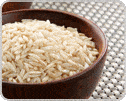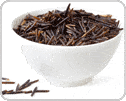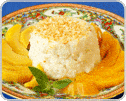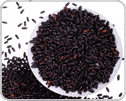
Written By: Sejal Dave, RD
Title: Registered Dietitian
Alumni: University of Florida
Last Updated on:

Rice is a staple food that is eaten all around the world. It’s a cereal grass that is cultivated for its edible grain. Although the definition of rice is quite straightforward, the different varieties and forms can make it difficult to choose what’s best for a diabetes meal plan. The following list provides a breakdown of popular rice varieties and the amount of carbs and glycemic index for each.

Table of Contents
 Basmati RiceBasmati rice has longer grains or kernels than other rice varieties. It’s known for its distinct flavor and aroma – the taste has been compared to roasted nuts or popcorn. Basmati rice is predominantly used in Indian cuisine, but can be used with various dishes. The kernels cook lengthwise, which results in long, free-flowing rice that is fluffy rather than sticky. Basmati rice is available in both brown and white varieties.
Basmati RiceBasmati rice has longer grains or kernels than other rice varieties. It’s known for its distinct flavor and aroma – the taste has been compared to roasted nuts or popcorn. Basmati rice is predominantly used in Indian cuisine, but can be used with various dishes. The kernels cook lengthwise, which results in long, free-flowing rice that is fluffy rather than sticky. Basmati rice is available in both brown and white varieties.
 Wild RiceWild rice is known for its nutty flavor and chewy texture. It’s made up of four different types of grasses from the genus Zizania. It is native to the area around the Great Lakes, where Native Americans harvest it, so it is also known as Indian Rice. Because of the popularity of wild rice, it’s also commercially produced (i.e. not wild anymore) and readily available.
Wild RiceWild rice is known for its nutty flavor and chewy texture. It’s made up of four different types of grasses from the genus Zizania. It is native to the area around the Great Lakes, where Native Americans harvest it, so it is also known as Indian Rice. Because of the popularity of wild rice, it’s also commercially produced (i.e. not wild anymore) and readily available.
 Sticky RiceSweet, sticky, or waxy rice is a short-grain Asian rice, which, as its name implies, is sticky and gelatinous. It can have a sweeter taste than other rices and can be used as a savory side dish or as a dessert, depending on the cuisine. It has a higher glycemic index value than other rice varieties. Sweet rice is often considered to be high in gluten, but this is not the case. It is gluten-free and safe for people who have gluten-sensitivity.
Sticky RiceSweet, sticky, or waxy rice is a short-grain Asian rice, which, as its name implies, is sticky and gelatinous. It can have a sweeter taste than other rices and can be used as a savory side dish or as a dessert, depending on the cuisine. It has a higher glycemic index value than other rice varieties. Sweet rice is often considered to be high in gluten, but this is not the case. It is gluten-free and safe for people who have gluten-sensitivity.
 Black RiceBlack rice is unique not only for its color, but also because it’s high in bran and antioxidants. It is described as having a nutty, floral taste that’s almost fruity. Although it’s not as common as other rice types, its popularity is increasing because of its healthy profile. According to Chinese legend, black rice was only for Emperors because of its high nutrient content, rare color, and highly unusual taste.
Black RiceBlack rice is unique not only for its color, but also because it’s high in bran and antioxidants. It is described as having a nutty, floral taste that’s almost fruity. Although it’s not as common as other rice types, its popularity is increasing because of its healthy profile. According to Chinese legend, black rice was only for Emperors because of its high nutrient content, rare color, and highly unusual taste.
A diabetes meal plan can definitely include rice – in fact, it’s part of the grain/starch food group, which makes up a large part of a balanced meal plan. For people with diabetes, the focus should be on portion control and individual taste preference. The glycemic index can help guide your choice, but remember that each person responds differently to foods. It is best to check your blood sugar level two hours after a meal to see how you respond to rice and other foods.
Alumni: University of Florida – Sejal is a registered dietitian, a certified diabetes educator and she holds a masters degree in nutrition and health. Sejal was the project coordinator for the Veteran’s Administrations (VA) national weight loss program and previously worked for the VA hospital in Tampa, FL as a Spinal Cord Injury dietitian.
Sejal has had numerous clinical and community education experiences, including pediatric and intensive care nutrition support. She has also had the opportunity to teach nutrition courses at the community college level to students interested in pursuing health professions. One of her favorite areas of education is diabetes management.
basmati rice, black rice, blood sugar, diabetes, diabetes diet, sugar, wild rice